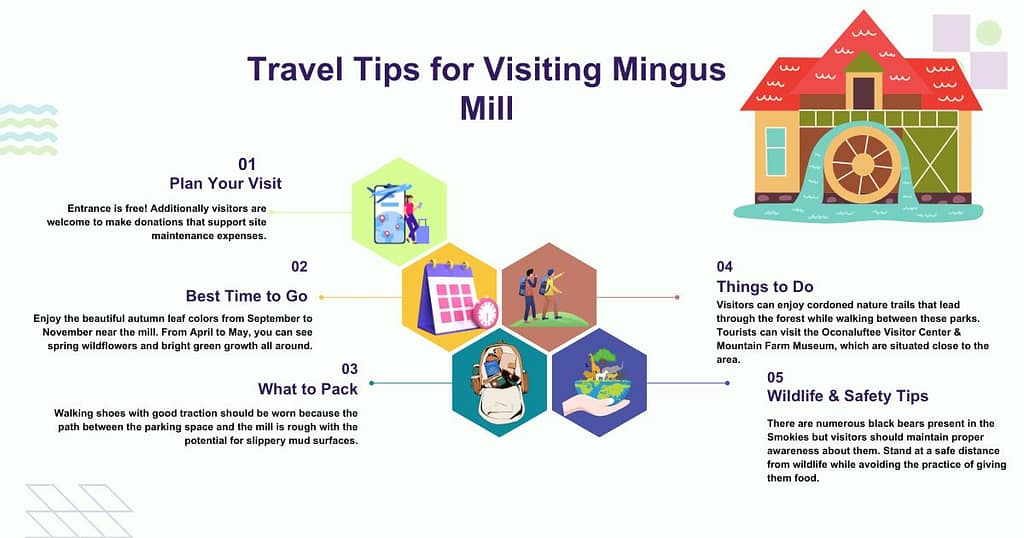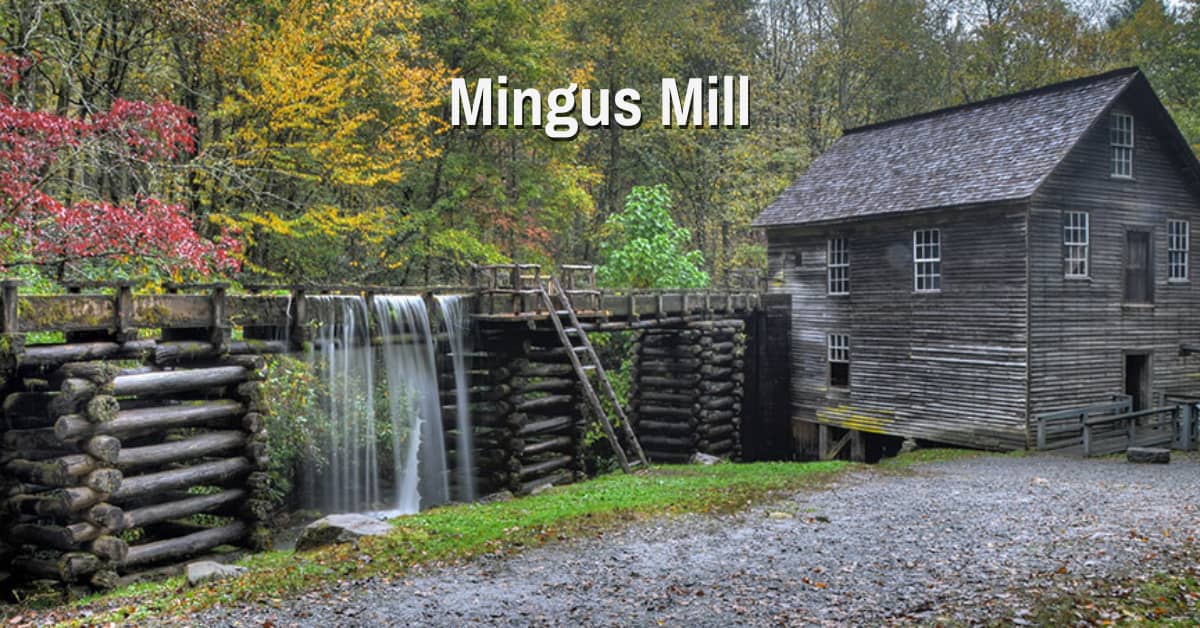The Great Smoky Mountains National Park has several captivating historic structures. Inside the national park, you can explore Mingus Mill.
This antique grist mill is beautifully preserved. When strolling around Mingus Mill, you can learn a great deal about the area’s history and how early settlers lived in this region.
Here is everything that you should know about Mingus Mill and how to visit this splendid structure.
1. Introduction to Mingus Mill
Mingus Mill, hidden in the beautiful Great Smoky Mountains National Park, showcases 19th-century Appalachian innovation.
Built in 1886, this water-powered grist mill still grinds cornmeal. Visitors can see history in action here.
Mingus Mill is easy to reach from the Oconaluftee Visitor Center, just 5 miles from Cherokee, North Carolina. It’s a must-see for history lovers, nature fans, and curious travelers.
Why visit Mingus Mill
Mingus Mill is an old building that shows how Appalachian settlers lived long ago. There are several compelling logical reasons for everyone to plan a visit to Mingus Mill.
- A historical mill at Mingus still operates today. It uses water power to grind cornmeal, just like in the past.
- Nature lovers will enjoy this site. The mill and nearby forested hills, along with walking paths and resting areas, make it great for exploration.
- The biggest educational benefit comes from learning about 19th-century milling methods. This helps us understand Appalachian heritage and how to use sustainable water power systems.
- Visiting the Oconaluftee Visitor Center and Mountain Farm Museum is a fun way to explore Appalachian traditions.
2. How to Get to Mingus Mill & Trail Details
Mingus Mill Location
Mingus Mill provides easy access to Cherokee, NC, because it rests five miles away from the Oconaluftee Visitor Center.
Travelers can reach Bryson City by car in just ten minutes. This makes it a great spot for anyone visiting the area.
Location: Mingus Creek Trail, Cherokee, NC 28719, United States. Get Direction
Mingus Mill Trail Information
| Trail Name | Mingus Mill Trail |
| Distance | 9.5 km round-trip |
| Time | 3 hours 17 minutes |
| Elevation | 460 m |
| Difficulty | Easy, family-friendly hike |
Trail Route
The Mingus Creek Trailhead is at the far end of the Mingus Mill parking lot. The trail crosses Mingus Creek several times, using wooden bridges.
- The trail heads north 2.9 miles to the Thomas Divide Trail after traveling 2.9 miles to the junction of the Deep Low Gap Trail.
- Take the 10.8-mile Mingus Creek Trail to Deep Low Gap Trail to Indian Creek Trail to Deep Creek for a longer (and possibly two-day) hike.
- Along this trek, you can reach backcountry shelters 51 and 46.
- Wet trails can get muddy after rain. So, people should wear waterproof shoes for comfort.
3. History of Mingus Mill Great Smoky Mountains
On the Mingus family’s land, Mingus Mill was constructed in 1886. The majority of the wood used to build the mill came from tulip trees.
The biggest grist mill in the Smoky Mountains was called Mingus Mill. Mingus Mill powered its mill stones by a steel turbine, in contrast to the majority of mills at the period that used wooden wheels.
Mingus Mill’s success can be attributed in part to this. More than 200 local families were served by the mill during its height.
On Saturdays, the miller would grind the grains that the locals brought to the mill. Members of the community would converse with friends and family and exchange things while they waited.
As a result, Mingus Mill became a hub for community interaction and business. From the time of its construction in 1886 until its sale to the national park in 1930, the mill was owned by the same family.
The Mill’s Operation
The turbine at Mingus Mill is powered by water, just like the majority of grain mills. Mingus Creek water enters the millrace, a type of flume.
The water accelerates through the millrace channel as it moves downward. In order to prevent dirt, leaves, or twigs from getting to the turbine, it is additionally filtered along the way. A 22-foot drop awaits you after the millrace.
Water is poured into a reservoir, or penstock, by this drop. After that, the water enters the turbine’s mechanisms, which rotate the blades.
The enormous millstones in the mill building are then rotated by the turbine’s blades. The grain is ground into flour, cornmeal, etc. by turning the millstones.
Mingus Mill Today
One of the most visited historic sites in the Smoky Mountains today is Mingus Mill.
When you visit Mingus Mill, you may observe the mill’s internal operations as well as the water flowing through the millrace outside.
On certain days, you may even observe the milling operation in progress.
An on-duty miller leads the demos. They are ready to answer your questions and share stories about Mingus Mill’s history.
Additionally, Mingus Mill cornmeal and other regional goods will be available for purchase! April through October, as well as the weekends in November, the mill is manned.
You can still walk the walkways and view the outside structures if you visit in the winter, but you won’t be able to enter the mill.
4. Outdoor Activities Near Mingus Mill, NC
Visitors can enjoy the scenic beauty of the Great Smoky Mountains. Mingus Mill opens the door to many outdoor activities.
Scenic Walking Trails- Oconaluftee River Trail
Distance: 3 miles round-trip
Difficulty: Easy
This family-oriented trail along the river leads visitors towards the Oconaluftee Visitor Center.
- The trail is well-kept for everyone. Strollers and wheelchairs can easily pass over the smooth ground.
- Additionally, you should bring a camera because wildlife sightings, including elk and deer, and birds, are frequently seen throughout the path.
Wildlife Watching
Mingus Mill is a great place to see many types of wildlife. Wildlife lovers and photographers enjoy this national park.
It offers a natural refuge filled with various animal species.
Common Wildlife Sightings:
- Elks present themselves by grazing the open fields that run adjacent to the Oconaluftee Visitor Center.
- You can frequently observe deer since they spend time exploring both trails and woodland regions.
- Wild turkeys take to the fields and trails for their wanderings, particularly during morning hours.
- Multiple types of woodpeckers, together with warblers and owls, can be observed throughout the park.
5. Travel Tips for Visiting Mingus Mill in 2025
Here’s some travel advice for visiting Mingus Mill. It’s a historic gristmill located in the Great Smoky Mountains National Park, near Cherokee, North Carolina.

Plan Your Visit
The site is open year-round. The mill machinery runs from mid-April to October.
- Entrance is free! Additionally, visitors are welcome to make donations that support site maintenance expenses.
Best Time to Go
Enjoy the beautiful autumn leaf colors from September to November near the mill.
- From April to May, you can see spring wildflowers and bright green growth all around.
- During the summer, from June to August, the weather is warm and pleasant for visitors. However, the venue can get crowded with tourists.
- In December, January, and February, the mill looks magical under winter snow. However, access to the site may be limited.
What to Pack
Walking shoes with good traction should be worn because the path between the parking space and the mill is rough with the potential for slippery mud surfaces.
- A photographer will find joy at Mingus Mill since the wooden sluice and rustic charm make for ideal subjects.
- Bring bug spray & sunscreen. It will help in protection from mosquitoes and sun exposure.
- Pack your bags with a water bottle and some snacks to munch on along the way.
Things to Do
Watch as the turbine mill operates to produce fresh cornmeal when the facility is in operation.
- Visitors can enjoy cordoned nature trails that lead through the forest while walking between these parks.
- Tourists can visit the Oconaluftee Visitor Center & Mountain Farm Museum, which are situated close to the area.
Wildlife & Safety Tips
There are numerous black bears present in the Smokies, but visitors should maintain proper awareness about them.
- Stand at a safe distance from wildlife while avoiding the practice of giving them food.
- Mingus Mill is a historic site, so visitors should not climb on the structure or touch the sluice gate.
- Visitors should check the weather. Fog and wetness often occur after rain.
6. Facts to know about Mingus Mill
Mingus Mill is unique and not simply another mill. Here are some interesting facts about Mingus Mill that you did not know.

Enslaved People’s Cemetery and Coin Leaving
One of the earliest families to settle in the Oconaluftee River valley in 1790 was the Mingus family.
- The graves of those who were enslaved by wealthy families, who were common at that period, are located close to Mingus Mill.
- This peaceful location, which sits on top of a hill next to the parking lot, is worth stopping at. To locate it: The trailhead for the Mingus Creek Trail is located at the far end of the parking lot, marked by a fence.
- A well-traveled route leads to the cemetery approximately 75 feet up a slight hill to the right of the entrance.
- Only rocks are used to identify the graves’ heads and feet; there are no names, dates, or headstones.
- Coins are occasionally discovered on graves. Coins are a sign that you were there and showed respect. To “pay the ferryman to safely get the departed soul to the afterlife,” some coins are also believed to be left behind.
It’s Possible to Spot Fish in the Flume
Some components of Mingus Mill’s operation are rather straightforward. Water from Mingus Creek flows to the flume through the mill race.
- This process speeds up the water, keeping the pen stock full while the mill runs.
- You might see a fish in the flume throughout the summer, like this brown trout.
A Community Crossroads
The mill’s history extends far beyond the building and its activity. During the late 1800s and early 1900s, Mingus Mill served as a crossroads for local villages.
- Families along peaks and valleys would work on their crops, animals, and chores during the week to prepare for Saturdays at the mill.
- They would go a long way to have their corn milled, but they would also bring other items and skills to trade with others waiting their turn at the mill. It was the “grocery store” of its era.
- This was how the early settlers made a living, and life revolved around traveling (and even walking) several kilometers to the mill.
The mill was built for only $600
Dr. John Mingus hired Sion Thomas Early to build the structure, and he agreed to do it in three months for $600. His initials, “STE,” are carved onto the front gable, just beneath the eaves.
- The Mingus-Floyd family owned the mill until 1930, when it was sold to the newly established National Park.
- The lumber used to construct Mingus Mill was sourced locally during a brief logging boom.
- It was milled in Smokemont, which is now a campground but was formerly a thriving timber camp.
Conclusion | Mingus Mill Guide
At Mingus Mill, visitors find a blend of culture, stunning scenery, and history. The historic mill offers a memorable experience.
Guests can learn about its fascinating history, water-powered technology, and beautiful surroundings.
The Oconaluftee Visitor Center, Mountain Farm Museum, and Mingus Mill offer a deep dive into Appalachian heritage. Nearby hiking trails add to the natural beauty of the Great Smoky Mountains.
Become ready to embark on a historical adventure at Mingus Mill. Plan your visit today!
Elk Hollow Resort offers the perfect place to stay. You can easily visit Mingus Mill and explore attractions in the Great Smoky Mountains.
Mingus Mill Guide FAQs
1. What is Mingus Mill?
Mingus Mill is a historic, water-powered grist mill located in the Great Smoky Mountains National Park. Built in 1886, it still grinds cornmeal using a steel turbine rather than a traditional waterwheel.
2. Where is Mingus Mill located?
Mingus Mill is situated near Cherokee, North Carolina, just five miles from the Oconaluftee Visitor Center in the Great Smoky Mountains National Park.
3. What are the operating hours of Mingus Mill?
The mill is open from mid-April through October, with demonstrations available during this period. It is also open on weekends in November. The surrounding area is accessible year-round.
4. How much does it cost to visit Mingus Mill?
Admission to Mingus Mill is free, though donations are appreciated to help with maintenance and preservation.
5. Can I buy fresh cornmeal at Mingus Mill?
Yes, freshly ground cornmeal is available for purchase during the mill’s operating season.
6. Is there a hiking trail near Mingus Mill?
Yes, the Mingus Creek Trail starts at the mill parking lot. It is a 9.5 km (5.9 miles) round-trip hike and is great for nature lovers. The Oconaluftee River Trail, an easy 3-mile round-trip walk, is also nearby.
7. What wildlife can I see at Mingus Mill?
Visitors often see elk, deer, wild turkeys, and woodpeckers around the mill and nearby trails.
8. Can I visit Mingus Mill in the winter?
Yes, you can visit in winter, but the mill may be closed. You can still explore the exterior and enjoy scenic winter views.
9. What should I bring when visiting Mingus Mill?
- Comfortable walking shoes
- A camera for scenic and wildlife photography
- Bug spray and sunscreen
- A water bottle and light snacks
10. Is Mingus Mill family-friendly?
Yes! The mill is an easy-to-access historic site, and the nearby trails are suitable for families with children.
11. Is Mingus Mill wheelchair accessible?
The area around the mill is relatively flat, but some paths may be uneven. Visitors using wheelchairs may need assistance.
12. What are some nearby attractions to visit?
- Oconaluftee Visitor Center & Mountain Farm Museum (5 miles away)
- Clingmans Dome (30 minutes away)
- Great Smoky Mountains Railroad in Bryson City (10 minutes away)



